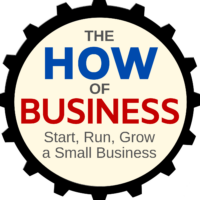Profit & Loss and Cash for Small Business.
Advanced Profit & Loss Statement (P&L) concepts and how to monitor the cash in your small business, with serial entrepreneur Henry Lopez.

On this episode Henry shares additional concepts, tips and thoughts on using your financial statements to help you run and grow your small business. Specifically, he goes a bit deeper into the Profit & Loss Statement, and introduces the Cashflow statement.
At a high level, it’s about answering the question: Are you making or losing money in your small business and where is all your cash?
Previously, on episode 397 of this podcast, Henry explained the essentials of the Profit & Loss statement. If you feel you need to start with the fundamentals of how to use your P&L, then you may want to listen to episode 397.
Your Statement of Cashflow, or your Cashflow Statement, is a financial report that details how cash entered and left your business during a period of time. In other words, the cashflow statement provides you with a more detailed picture of what happened to your business’s cash during an accounting period, like this past month. The same basic calculation can also be used to forecast how much cash you will need in a future period of time.
The cashflow statement is one of the three principal financial statements, along with the P&L (also called the income statement) and the balance sheet. These are arguably the three most important financial statements for your small business.
Henry covers these topics from a small business owner’s perspective. Henry is not a CPA or Accountant, so his tips and suggestions are based on his experiences as an owner of multiple small businesses over the years, and his experience as a coach and consultant for many other small businesses. He focuses on high-level tips and suggestions for how to use your P&L and Cashflow Statement to help you run and grow your small business.
We encourage you to consult with your accountant or CPA about your financials, and continue learning more about how to interpret your financial statements.
Free Download: Sample Profit & Loss Statement
Profit & Loss and Cash for Small Business
Financial statements help you measure the financial health of your small business. The P&L Statement provides you with a snapshot of your financial performance in a prior period of time – in the previous month, quarter, or year for example. And the Cashflow Statement shows you the flow of cash through your business for a period of time.
Your Profit and Loss statement details your business’ income and expenses over a defined period. The Profit & Loss statement is also referred to as a P&L, income statement, statement of profit, statement of operations, and a profit and loss report. Ideally, you produce a P&L every month or quarter at the most.
The simple formula for the P&L is:
- Revenues or Sales
- Minus Cost of Goods Sold
- Equals Gross Profit (Gross Profit Margin %)
- Minus Operating Expenses
- Equals Net Operating Income (Net Operating Margin %) – also called Net Profit and Net Profit Margin
Advanced concepts related to your P&L Statement:
Most of the concepts below relate to the fact that your P&L does not capture all of what happened to the cash in your business – it only captures the financial operating performance of the business for a specific period. Measuring the financial performance of your business. But you also definitely need to know how much cash you have and how much you will need in the future. Particularly if you are about to invest in equipment or purchase a large amount of inventory.
- Business Loans: If you have business loans, you must consider that only the loan interest payments appear on your P&L, but not the portion of your loan payment that went to reducing the Loan Principal – but of course, the entire payment did consume cash and was taken out of your bank account. This is in part because only the interest is an expense from an accounting and IRS perspective. The paying down of the principle is reflected on your Balance Sheet, and the impact on your cash balance is reflected on your Cashflow statement – and of course, your bank account.
- Amortization/Depreciation: Your P&L may include expense line items for Amortization and Depreciation. These are accounting methods that allow for the cost of business assets to be expensed each year over the life of the asset. The expense amounts are then used as a tax deduction, reducing the tax liability of the business. When you buy an asset, like a piece of equipment that costs $5,000 for example, the IRS may not allow you to deduct the entire amount of that expense in one year. When you do make these types of investments, be sure to consult with your CPA to determine how to best treat the investment for the best tax treatment, and to comply with IRS regulations. Instead, you will likely expense that $5,000 purchase over a number of years (the number of years depend on the IRS rule that applies to this type of asset). And just that portion is what appears on your P&L, even though you spent the entire $5,000 up front. Amortization and depreciation are the two main methods of calculating the value of these assets. The primary difference between the two methods depends on the type of small business asset being expensed. Basically, Amortization is the accounting practice of spreading the cost of an intangible asset, something that’s not physical, over its useful life. Intangible assets include Goodwill, intellectual properties (Trade Secrets, Patents, Trademark and Copywrites), licenses, proprietary customer lists, and research & development investments. Depreciation is the expensing of a fixed asset over its useful life. Fixed assets are tangible objects acquired by a business, like buildings, equipment, office furniture, vehicles, and machinery. Unlike intangible assets, tangible assets might have some value when your small business no longer has a use for them. Depreciation is calculated by subtracting the asset’s salvage value or resale value from its original cost. The difference is depreciated evenly over the years of the expected life of the asset. The depreciated amount expensed in each year is a tax deduction for your small business until the useful life of the asset has ended, and this yearly depreciation is included on your P&L statement. Unless you are an accountant, you don’t want to try to calculate amortization or depreciation – get the guidance of an accountant or CPA on this.
- Inventory: The inventory you have on-hand in your small business is typically paid for in full, and remains in stock until you consume or sell it. Your P&L only shows the used portion of inventory for a period of time. The balance of your inventory on-hand, that you have already spent cash on, is reflected on your Balance Sheet as an Asset.
- Cash vs. Accrual: Accrual accounting is a financial accounting method that allows your small business to record revenue before receiving payment for the goods or services you have sold, and expenses are recorded as incurred before the you have paid for them. This method is much more complex, and often not used by small business for the reporting that supports their operations. Cash accounting is the other accounting method, which recognizes transactions only when payment is exchanged. This method is much easier to execute for small business owners, and it provides a more accurate picture of your financial position and your cash position. But if you have unearned revenue, for example, then you may be better off using the Accrual method. You will probably find that many CPAs recommend the Accrual method. We recommend that you discuss this with your CPA to determine which method is best for your small business.
- Cost of Goods Sold: All businesses have Cost of Goods Sold (COGS), including service companies. You can use COGS to help you determine the profitability of your individual product or service lines. If you offer a product, then from an accounting perspective, you should always have COGS line items on your P&L. This includes all your raw materials (the cost of inventory or materials used to create your products) and the labor that goes in to making and/or installing that product.
Cashflow Statement – An Introduction:
Understanding the concepts of the Cashflow statement can be challenging if you’ve never used it or you are not an accountant. But at it’s basic level, it’s really quite simple.
The purpose of a cash flow statement is to provide a detailed picture of what happened to your business’s cash during a specified period. It provides a more accurate picture of your cash position, compared to the P&L.
The most important measure is weather you have a negative or positive flow. A prolonged negative cash flow, which is dipping into you cash reserves or working capital, can obviously lead to insolvency and the failure of your small business – you will simply run out of cash.
The simplest method for calculating cash flow, called the Direct Method, involves:
- Starting Cash
- Add all money collected (in the bank)
- Subtract all of the outflows of cash (including loan payments, inventory purchases, asset purchases, and COGS, and operating expenses).
- Equals your Ending Cash Position
At this simple and basic level, it’s no different than how you balance a bank account. But remember that your bank account may also include cash reserves and unpaid taxes.
Questions your Cashflow Statement will help you answer about your small business include:
- Do I have negative or positive cash flow?
- How am I consuming my cash reserves?
- How much cash will I need to cover my total outflows next month?
Where to start?
To get started with using your financial statements to help you run and grow your small business, you should…
- Have updated and accurate financial data.
- Implement a financial management tool like QuickBooks.
- Delegate bookkeeping – but don’t abdicate the responsibility of knowing your key financial performance indicators.
- Review your P&L monthly.
- Use your Cashflow Statement to monitor your cash position, and the flow of cash through your business. Do you have negative or positive cashflow?
- Continue learning about how to interpret your financials statements.
Resources:
Free Download: Sample Profit & Loss Statement
Books mentioned in this episode:
[We receive commissions for purchases made through these links (more info)].
Other Related Episodes:
You can find other episodes of The How of Business podcast, the best small business podcast, on our Archives page.

